海市高新技术产业发展及其就业效应研究
VIP免费
摘 要
随着高新技术产业的不断发展,其对相关产业发展以及就业的影响已成为研
究的热点。目前,主要有以下几种观点:第一种观点认为高新技术的运用提高劳
动者生产效率,将减少就业机会;第二种观点认为高新技术产业的发展促进大量
新兴产业和中间产业的发展,将会扩大就业空间,增加就业机会;第三种观点认
为高新技术产业对就业的影响,根据产业结构、时间跨度的不同,作用机制有所
不同。上海市作为中国最大的城市之一,近年来,借助其区位优势、科技优势以
及资源环境等综合优势,高新技术产业的发展势头迅猛,其对就业的影响也日益
明显,因此,根据上海市高新技术产业的发展特征以及其就业特征,深入研究两
者之间的关系,具有重要的理论指导和现实意义。
本文引入包含投入水平标、产出水平、效益水平以及潜力水平等四个因素的
综合评级体系,构建高新技术产业的发展度模型,对上海市高新技术产业的发展
水平进行测算。鉴于高新技术产业发展对就业的复杂机制,本文分别从就业总量
效应和就业结构效应两方面进行系统分析,指出高新技术产业的就业效应的作用
机制是通过影响劳动力生产率、需求结构和产业结构等方面来实现的;表现在就
业总量上为就业溢出效应和就业吸收效应,表现在就业结构上为三大产业的劳动
力就业量和就业比重呈现不同的规律。基于投入产出模型,本文从产业关联理论
角度来定性分析上海市高新技术产业对各行业的产出拉动和就业拉动效果,并采
用上海市 2000~2012 年间序列数据,建立包含科技水平、人力资本水平因素及制
度因素等五个方面的实证模型,运用 Eviews6.0 计量软件,对其就业效应的影响因
素进行分析。
实证结果表明:(1)目前,上海市高新技术各园区结合自身优势,不断完善自
身规划,形成了“一区八园”的新格局,高新技术产业规模不断壮大;(2)较之于
发达国家,上海市高新技术产业尚处于标准跟随阶段,其产业发展度仅是发达国
家的 67%,但考虑潜力因素,发展度将达到 89%,显示出强劲的发展潜力;(3)上
海市高新技术产业总体上对就业是促进作用,目前吸引就业能力还较弱,但潜力
较大,要通过高新技术产业发展,带动劳动力就业结构的相应调整;(4)上海市高
新技术产业就业效应的主要影响因素是科技水平、从业人员人力资本水平以及
R&D 经费投入三个要素,因此要通过专项人才培养、放宽融资政策、加大 R&D
经费投入等政策来促进高新技术发展与就业创造的良性互动。
关键词:高新技术产业 就业效应 投入产出 发展度模型
ABSTRACT
With the continuous development of new and high technology industries, its effect
to related industries and employment has become a research hotspot. There are mainly
three different points of view, the first one is that the development of new and high
technology industries will reduce employment opportunities by improving the labor
productivity; The second one is that it comes with series of emerging industry
and intermediate industry development and will expand employment space and increase
employment opportunities; The third one is that its effect on the employment changes
with industrial structure and different time span. As the biggest city in China, Shanghai
took advantage of its location,technology and environment, its new and high
technology industries booming with increasingly apparent effect on its employment.
As a result, to discuss new and high technology industries in Shanghai and how it
influences its employment has theoretical and realistic significance.
This paper aimed to constructed high and new technology industry development
degree model to calculate its development level in Shanghai by input levels, output
levels, efficiency levels and potential levels as a comprehensive rating index system.
The paper explained the complex mechanism between the industry and employment
from two aspects which were employment quantity effect including spillover effects and
absorption effect and employment structure effect. The result pointed out that the
mechanism was achieved by influencing the labor productivity, demand structure and
industrial structure. Based on input-output model, the paper aimed to qualitatively
analysis how new and high technology accelerate other industries in Shanghai from the
perspective of industrial connection theory and using time series data of Shanghai from
the year 2000 to 2012 to establish a empirical model including five factors which were
residents income level, institutional factors, industrial structure and the cultural factors
and on this base afterward ,the paper using Eviews6.0 to explain how this five factors
influenced the employment effect.
The empirical results show:(1) Currently, Shanghai Hi-tech Park takes their own
advantages and constantly improves their own plans to form a new pattern of "one area
and eight gardens" and the size is growing. (2) Compared with developed countries,
Shanghai high-tech industry is still in the standard follower stage, and only 67% of the
industrial development of the developed countries, but considering the potential factors,
the degree of development will reach 89%, showing a strong growth potential. (3)
Overall, the high-tech industry in Shanghai has promoted the employment of labor, and
the ability is still relatively weak, it has greater potential. Shanghai should converse
employment structure to promote technology leaps and bounds correspondingly. (4) The
main factors affecting the employment effects of the high-tech industry in Shanghai is
the wage of the residents and R&D investment, so Shanghai should focus on increasing
R&D investment in order to promote positive interaction between technological
progress and employment.
Key Words: High and New Technology Industry, the Effects on
Employment, Input-Output, Development Degree
Model
目 录
中文摘要
ABSTRACT
第一章 绪 论 ....................................................... 1
1.1 选题背景与研究意义 ........................................... 1
1.2 研究综述 ..................................................... 2
1.2.1 国外研究综述 ............................................ 2
1.2.2 国内研究综述 ............................................ 3
1.3 研究思路与研究方法 ........................................... 4
1.3.1 研究思路 ................................................ 4
1.3.2 研究方法 ................................................ 4
1.4 逻辑框架及研究内容 ........................................... 5
1.5 创新点及不足 ................................................. 6
第二章 相关概念界定及相关理论基础 ................................... 8
2.1 高新技术产业理论 ............................................. 8
2.1.1 高新技术产业含义 ........................................ 8
2.1.2 高新技术产业特点 ........................................ 9
2.2 产业发展理论 ................................................ 11
2.2.1 产业结构变动规律 ....................................... 11
2.2.2 需求结构演变规律 ....................................... 12
2.2.3 因子分析法 ............................................. 12
2.3 产业关联理论 ................................................ 14
2.3.1 产业关联理论原理 ....................................... 14
2.3.2 投入产出分析理论 ....................................... 15
2.4 劳动力就业理论 .............................................. 17
2.4.1 凯恩斯主义的就业理论 ................................... 17
2.4.2 新古典学派的就业理论 ................................... 17
第三章 上海市高新技术产业发展及就业效应分析 ........................ 19
3.1 上海市高新技术产业发展评价 .................................. 19
3.1.1 高科技园区产业布局 ..................................... 19
3.1.2 产业规模与产业结构特征 ................................. 19
3.1.3 发展水平综合评价 ....................................... 22
3.2 上海市劳动力就业评价 ........................................ 26
3.2.1 劳动力就业总量特征 ..................................... 26
3.2.2 劳动力就业结构特征 ..................................... 27
3.3 高新技术产业发展的就业效应分析 .............................. 30
3.3.1 就业总量效应分析 ....................................... 30
3.3.2 就业结构效应分析 ....................................... 32
3.3.3 就业效应计算 ........................................... 34
3.4 高新技术产业就业效应的因素分析 .............................. 35
第四章 上海市高新技术产业就业效应实证研究 .......................... 37
4.1 上海市高新技术产业就业效应实证 .............................. 37
4.1.1 模型假设 ............................................... 37
4.1.2 数据说明 ............................................... 38
4.1.3 实证结果及分析 ......................................... 39
4.2 上海市高新技术产业就业效应因素实证 .......................... 43
4.2.1 指标选取及数据说明 ..................................... 43
4.2.2 计量模型构建 ........................................... 45
4.2.3 实证回归结果及分析 ..................................... 45
4.3 本章小结 .................................................... 48
第五章 结论与政策建议 ............................................. 49
5.1 主要结论 .................................................... 49
5.2 政策建议 .................................................... 50
5.2.1 加强园区布局调整 ....................................... 50
5.2.2 提高企业自主创新 ....................................... 50
5.2.3 调整宏观金融政策 ....................................... 51
5.2.4 规范企业法律环境 ....................................... 52
5.2.5 健全专项人才培养机制 ................................... 53
5.3 研究展望 .................................................... 54
附 录 ............................................................. 55
参考文献 ........................................................... 69
在读期间公开发表的论文和承担科研项目及取得成果 ..................... 73
致谢 ............................................................... 74
第一章 绪论
1
第一章 绪 论
1.1 选题背景与研究意义
近年来,高新技术产业发展势头迅猛,东部沿海地区高新技术产业中心地
位日益加强,生产自动化的程度不断提高,高科技、脑力型、资本密集型的工
作岗位也大幅增加,并因此吸引了一大批高科技人才。“创新驱动,转型发
展”
1
是上海市牢抓战略机遇,积极推进“四个率先”和建设“四个中心”的关
键所在,也是其站在更高的起点上促进科学发展的必然选择。因此,坚持必须
以“创新驱动,转型发展”为指导,通过经济和社会各个方面、各个环节的协
调互补,努力实现新的突破和实质性的进展。
相对于传统产业,高新技术产业不仅具有较高的效益、资金密集度、渗透
性和产业附加值,并且对自然资源的依赖低、消耗少,从而能更利于实现经济
发展和环境建设的双重目标,也是实现经济结构战略性调整以及产业结构升级
的重要途径之一
2
;高新技术产业的发展促进了一系列新兴产业和中间产业的发
展,创造出更多的就业岗位,同时,高新技术开发区具有产业集中、机制灵
活、创新氛围良好以及人才密集的优势,对于刺激劳动力就业具有突破性的作
用。
上海市聚集大量外来人口,以及国内外高技能人才,这对调整上海市人才
结构,适应新的经济形势和产业结构具有重要意义,也可以保持城市的活力和
创新力。但在此过程中,随着外来人口的不断流入,公共服务相对缺乏,资源
分配不均衡的问题尤其严重,使得上海城市面临着严峻的劳动力就业压力考
验,并将造成新的城市“二元结构”问题。产业升级对职工素质、人力资本提
出了更高的要求,这与在岗职工整体素质低下、劳动力低效率之间存在着严重
矛盾,上海市急需通过新产业的发展来实现更好的人才配置。
在理论上,学者关于高新技术产业发展的就业影响并未达成一致观点。一
方面,高新技术发展带动了一系列中间行业和中间产品的发展,增加其产量,
从而增加劳动力就业岗位;另一方面,高新技术可以提高劳动生产率,提高资
本的有机构成,减少就业。同时,高新技术具有浓郁的地域特色,对于高新技
术产业和就业之间的关系,现有的研究缺乏系统性和针对性,在政策取向差异
较大。鉴于此,深入研究上海市高新技术产业的就业效应问题,在“创新驱
动,转型发展”的大背景下,利用高新技术发展扩大就业、优化就业结构意义
重大。
1
上海市人民政府发展研究中心主任周振华《解放日报》,2011-01-17
2
陈士能《中国集体经济》,2004-03-20
相关推荐
-
公务员思想政治教育研究VIP免费
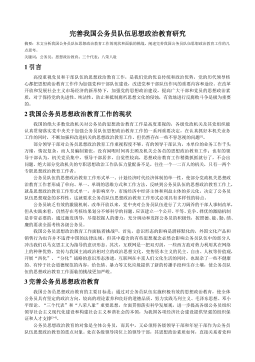
 2024-10-15 30
2024-10-15 30 -
在线社会网络中用户行为的实证分析与机制建模研究VIP免费
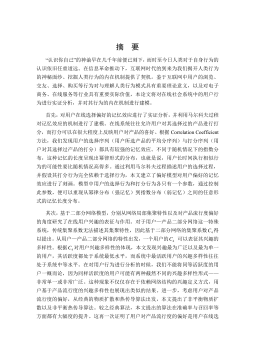
 2025-01-09 6
2025-01-09 6 -
智能优化方法对神经网络的改进及应用研究VIP免费
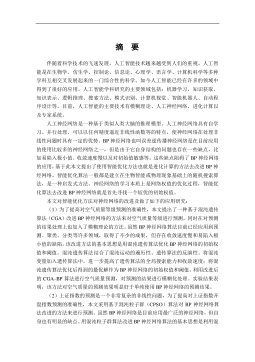
 2025-01-09 6
2025-01-09 6 -
鲜切哈密瓜保鲜技术研究VIP免费

 2025-01-09 8
2025-01-09 8 -
小城镇道路网级配方法及应用研究VIP免费
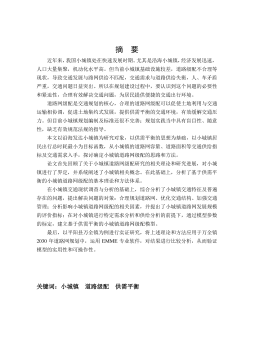
 2025-01-09 6
2025-01-09 6 -
医学信息集成测试系统的研究与实现VIP免费
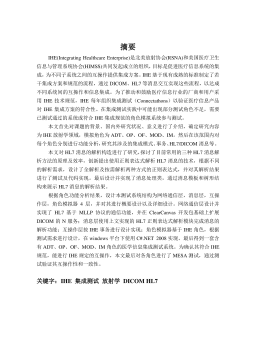
 2025-01-09 7
2025-01-09 7 -
余热驱动氨水吸收式制冷系统的理论及实验研究VIP免费
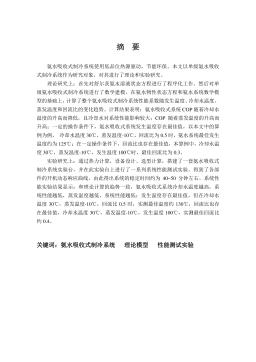
 2025-01-09 7
2025-01-09 7 -
喷雾降温技术适用性及热环境研究VIP免费
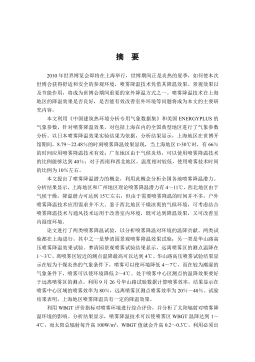
 2025-01-09 9
2025-01-09 9 -
收缩—扩张喷嘴的气泡雾化数值模拟VIP免费
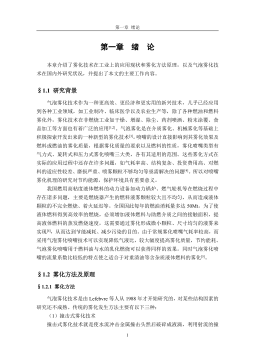
 2025-01-09 8
2025-01-09 8 -
支持供应链的工作流系统结构及其计划与调度的研究与应用VIP免费
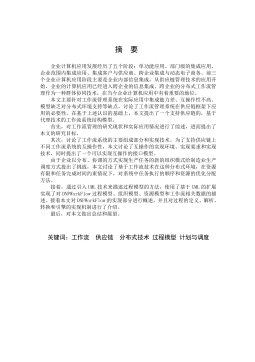
 2025-01-09 11
2025-01-09 11
作者:赵德峰
分类:高等教育资料
价格:15积分
属性:77 页
大小:3.63MB
格式:PDF
时间:2025-01-09
作者详情
相关内容
-

医学信息集成测试系统的研究与实现
分类:高等教育资料
时间:2025-01-09
标签:无
格式:PDF
价格:15 积分
-

余热驱动氨水吸收式制冷系统的理论及实验研究
分类:高等教育资料
时间:2025-01-09
标签:无
格式:PDF
价格:15 积分
-

喷雾降温技术适用性及热环境研究
分类:高等教育资料
时间:2025-01-09
标签:无
格式:PDF
价格:15 积分
-

收缩—扩张喷嘴的气泡雾化数值模拟
分类:高等教育资料
时间:2025-01-09
标签:无
格式:PDF
价格:15 积分
-

支持供应链的工作流系统结构及其计划与调度的研究与应用
分类:高等教育资料
时间:2025-01-09
标签:无
格式:PDF
价格:15 积分






